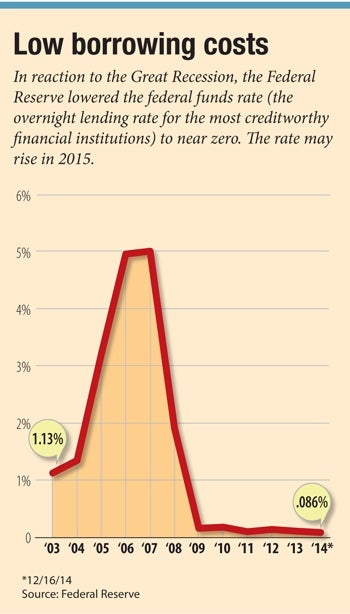Bankers in Central Massachusetts are keeping one eye on the local economy for signs of recovery and the other on Washington for signs of trouble.
Income statements for area financial institutions have improved significantly over the past three years, and banks across the region dodged a bullet when House and Senate leaders this month agreed to a deal that would avert budget gridlock in 2014. Bank executives expect a steady rebound in 2014, unless changes in federal policy manage to muck things up.
As the economy continues its slow recovery, so too do the area’s banks and credit unions. The last year has seen continued, measured economic growth and there’s little reason to expect anything dramatically different in 2015.
So, next year will be another of continued recovery for the financial industry in Central Massachusetts. Hovering over that will be the ongoing threats of cyberattacks and a shifting financial terrain caused by new, internet-facilitated payment and loan practices.
HERE’S WHAT TO WATCH IN 2015:
1. Interest rates remain low
The Federal Reserve will likely raise interest rates halfway through the year, according to most industry predictions, but even then it will be by less than one percent. Forty-six percent of economists in a December survey by the National Association for Business Economics predicted that the Fed will raise its key overnight lending rate in the third quarter, with the rate reaching only 0.75 percent by the end of 2015, compared to 0.845 percent in its previous survey, in September.
“The next six months, it looks like there will be very little change, and then July or later, maybe a half of a percent,” said Bryan Engelhardt, an associate professor of economics and accounting at Holy Cross. “You have to go into (2016 or 2017) to see a (federal funds) rate of 1 or 2 percent.”
This low interest rate environment will continue to have a positive impact on the housing market as mortgage rates remain low, he said, and will help other economic sectors grow because credit will be inexpensive.
2. Heightened loan demand
The low interest rates will also create a great environment for reinvestment, said Engelhardt, allowing more companies to make large investments.
In the last year, there has not been enough economic activity in Central Massachusetts to lead to true loan growth, according to Brian Stewart, executive vice president and chief financial officer for Middlesex Savings Bank, based in Natick. The banks have been cannibalizing loans from each other, he said, but an improving economy, even if it’s improving only slowly, will help drive demand for more loans.
“We anticipate there will be the ability to grow loans, probably modestly,” Stewart said. “There is not a lot of net new growth (this year) to satisfy everybody.”
3. Increasingly competitive deposit pricing
The increasing demand for loans will translate to a competitive market for deposits as banks look for money to fuel lending, Stewart said, explaining that this competition has already begun throughout Central and Eastern Massachusetts.
“As banks are able to grow their loans, they are going to be looking to fund them,” said Stewart. “I think the concern is to entice people.”
While many people have left time deposits, such as multi-year certificates of deposit, and gone to money funds with higher interest rates, Stewart foresees a return to time deposits.
“Borrowers will start to charge a little bit more for their loans and the banks will begin to raise their deposits, so depositors will start to benefit from the rising rate environment,” he said.
4. Cybersecurity concerns continue
In 2014, it seemed you could not go a week without hearing about another data breach exposing the personal and financial information of people and companies. In the last year, data from 96 million credit cards were exposed during breaches at Home Depot and Target. These kinds of breaches will be an ongoing theme well into the future of banking and finance, said Bruce Spitzer, a spokesman for the Massachusetts Bankers Association.
“We in the banking industry are sick and tired of it. These are usually breaches that are created by sloppy retailers that are not invested enough to keep their systems secure,” he said. “Retailers do not have enough skin in the game … It will be an ongoing thing until they have more responsibility for covering the losses.”
He said the banking industry is watching the development of state legislation that would put more responsibility on retailers. The nationwide mandate for retailers to accept cards that use a computer chip system that’s more secure than the traditional magnetic strip is a step in the right direction, albeit well behind many other countries that have already implemented the technology, he said.
5. Electronic payments and loans increase
The Internet will continue to play a prominent role in banking through a multitude of alternative payment types that include Apple Pay and Google Wallet, while banks push for wider use of their mobile-banking applications.
“That trend continues to grow and the traffic going into bank branches continues to slowly decline and the use of checks continues to decline as people use other forms of electronic payments,” Stewart said.
On the horizon are peer-to-peer lending organizations that eliminate banks by using the Internet to match those looking for loans with people looking to invest their money, said Engelhardt. LendingClub, which was founded in 2007 and is one of the primary companies in this space, recently raised $9 billion in capital through an initial public offering.
Spitzer counters that not everyone has made the transition to digital. Many still look for a local branch when they want to select a bank. Also, although they offer increased convenience as they become more popular, the security of these various digital payment methods may present their own vulnerabilities. It’s simply too early to tell, Spitzer said.
“It’s a constant struggle, balancing convenience with security,” he said.

